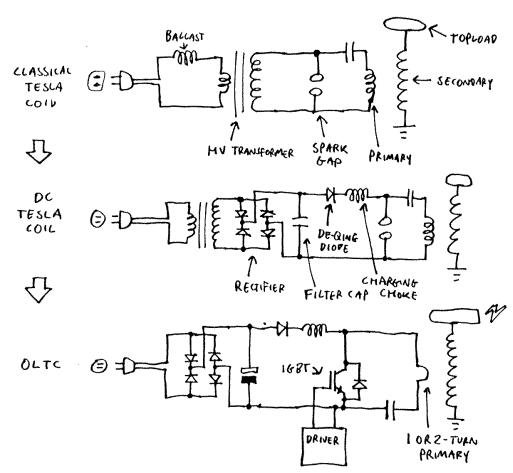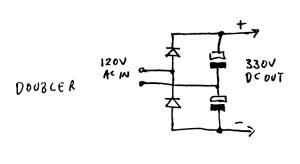OLTC FAQ 1.0
Q: What is an OLTC?
A: OLTC= Off-Line Tesla Coil. Invented by famous American coiler Terry Fritz. It almost ended up being called the "Fritz Generator". It is similar to a classical Tesla coil, but with a solid-state switch in place of the spark gap, and the power supply comes directly from the wall socket without any kind of HV transformer. It is actually a direct evolution of the DC Tesla coil.

Q: All the OLTCs built so far run off 240 volt AC. I only have 120. Can I still run one?
A: Yes, use a doubler to give you 330 volts DC for a 120 volts AC input. You won't be able to make full use of 1200V IGBTs, though. These require a doubler running off 240V AC. Using a step-up transformer will work fine, but large pieces of iron are against the OLTC philosophy.

Q: What are the advantages of the OLTC over a spark-gap coil?
A: No HV transformer or spark gap needed. Lower voltages in the primary circuit mean reduced insulation and safety requirements. Can fire at very high and very low rates. Extra geek points due to high complexity.
Q: What are the advantages over a SSTC?
A: Bigger sparks for the same power input. Theoretically, an advanced pulsed SSTC could equal it, but this has not been done yet. (EDIT: The DRSSTC by Jimmy Hynes achieved 66" sparks with about 1.1kW input: this is better than any OLTC to date. See it here.)
No gate drive transformers to worry about.
Q: What are the disadvantages of the OLTC compared to a spark-gap coil?
A: It's harder to achieve high energies, so the sparks are not quite as long for a given power input. (The best OLTC performance to date is 13" sparks for 300 watts input.) IGBTs are easier to wreck than spark gaps. A small OLTC might not do anything without a breakout point. Finally, the OLTC has complex electronics in it. The complexity is similar to an SSTC.
Q: What are the disadvantages compared to a SSTC?
A: The OLTC does not do any of the special effects like sword sparks and flames. The sparks look similar to sparks from a classical coil. It (probably) can't be audio modulated. The driver electronics are all live, so troubleshooting is impossible without an isolating transformer.
Q: I have this big transistor looking thing that I pulled out of a (inverter, laser power supply, microwave oven, dishwasher, killer satellite, etc). Can I build an OLTC with it?
A: Right now we believe that IGBTs are the only semiconductor that will work in the OLTC. But nobody has ever tried making one with MOSFETs, thyristors, triacs, sidacs, etc, so we can't say. Note, the IGBT needs to have a diode between emitter and collector. Some IGBTs have it built in, if not, you have to add an external diode with similar voltage/current ratings to the IGBT.
Q: What is an IGBT?
A: IGBT= Insulated Gate Bipolar Transistor. A souped-up MOSFET with an extra junction that boosts the conductivity. It is more efficient at high voltages and currents than the MOSFET, just as easy to drive, but slower in switching speed. The Drain and Source terminals are renamed to Collector and Emitter.
Note: MOSFETs have a parasitic diode built into the structure, which can sometimes be useful. Because of the extra junction, IGBTs end up with a thyristor instead, which is absolutely useless. In fact, it's positively dangerous, because extreme overloads can trigger it, causing the device to "latch up" and self-destruct. The latest ("third-generation") IGBTs are much more resistant to latchup.
Q: OK, I managed to get some IGBTs, how much current are they good for?
A: There are two types of IGBTs: discretes, and modules (also known as "bricks"). Discretes contain a single silicon chip and modules contain several connected in parallel. One particular discrete IGBT, the IRG4PF50WD from International Rectifier, has been tested in OLTCs at over twice the "maximum pulsed collector current" (Icm) of 204A shown on the datasheet. Some experimenters have claimed over 5x Icm. The secret is to apply more than the absolute maximum gate voltage. This is usually 20 volts, so we use between 25 and 36V. We have not tested IGBT bricks beyond 1.25x Icm so far, but there seems to be no reason not to push them to 2x Icm at least. (EDIT: I have tested the 600A Powerex bricks at 2500A, which is 2x Icm and they survived)
Q: I have several IGBTs, can I connect them in parallel to get more current?
A: Yes. But: They must all be the same type and ideally the same batch. You must keep the connections between them as short and thick as possible to minimise stray inductance, otherwise they might not share the current evenly. Also, make sure they are in good thermal contact, ie all mounted on the same heatsink.
Q: What kind of drive circuit do I need?
A: Unlike a SSTC, where you turn the MOSFETs on and off at several hundred kHz, in the OLTC you charge the tank capacitor up and then turn the IGBTs on. The primary current starts to oscillate just as it does in a spark-gap coil. The positive half-cycles flow in the IGBT part, and the negative ones flow in the diode. When the waveform reaches its first "notch", the IGBTs are quickly turned off, trapping the energy in the resonator, where it will hopefully burst out in a nice display of sparks. You can then recharge the tank capacitor and fire again.
So you need a circuit that can generate a pulse of adjustable length (usually between 10 and 50 microseconds) and repetition rate (usually between 1 and 1000 pps). Also, the driver has to have a high current capability to switch several large paralleled IGBTs quickly, and it may have to deliver up to 36 volts, so standard gate driver chips like the TC442x are no good. There are currently five driver circuits in existence, Terry Fritz's original, and four of mine.
Terry's schematic is in here somewhere :(
My first attempt
My second attempt
My third attempt (for IGBT bricks)
My fourth circuit is not written up yet
Q: How many primary and secondary turns should I use? What size of secondary former? What topload? What tank capacitor? What should I have in my sandwiches?
A: These are difficult questions, especially the one about the sandwiches. They all depend on what parts you're starting out with. For instance, if you are building the coil around a couple of big IGBTs that you picked up on EBay, your design should start out from the voltage and current capacity of the IGBTs, which will tell you the bang energy, which in turn tells you the height of the secondary, and so on.
Most of the design guidelines for spark-gap coils still apply. The exceptions are: the secondary aspect ratio which should be much fatter (between 2:1 and 3:1) and the number of secondary turns (around 2000). The primary will probably end up having only one or two turns, and the MMC tank cap will be an odd-looking thing with lots of 1uF capacitors in parallel.
Q: How do I tune an OLTC? I can't tap the primary because it only has one turn.
A: Add/remove capacitors from the tank cap array, raise/lower the topload, or change the size of the topload. Or make a trombone-like primary coil that slides in and out.
Q: How do I adjust the quenching?
A: Very carefully! The IGBT should always turn off on a negative half-cycle, when all the primary current is flowing in the diode. If it tries to turn off on a positive half-cycle, the current will be interrupted suddenly, causing an inductive kickback that may break it down and destroy it. If you just spin the quenching control for maximum spark output, it's inevitable that you will hit some positive half-cycles at some point. Therefore you should either use a driver circuit with soft turn-off, or set the quenching up at low power using an oscilloscope. A couple of Transzorbs connected between emitter and collector of your IGBT(s) are also good as a second line of defence.
Q: What is a Transzorb?
A: Transzorb is a trade name for an avalanche diode transient voltage suppressor (TVS). It is like a zener diode but rated for pulse currents of hundreds of amps. Available in various voltage ratings. Can be used in series to boost voltage rating or in parallel to boost current rating.
FAQ by Steve Conner (steve_at_scopeboy_dot_com) 03/08/03 Revised 12/11/03

